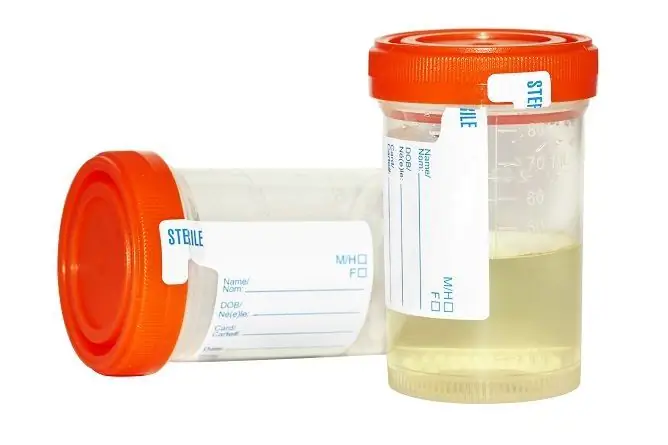- Author Rachel Wainwright [email protected].
- Public 2023-12-15 07:39.
- Last modified 2025-11-02 20:14.
How long is angina treated: how long does angina of different forms last
The content of the article:
-
How long is angina treated
- Catarrhal form
- Follicular form
- Lacunar form
- Necrotic ulcerative form
- Phlegmonous form
- Fungal form
- How many days is sore throat contagious
- Video
How long is angina treated in time? In order to establish this, the otolaryngologist needs to determine the form and etiology of the disease. The duration of therapy directly depends on the patient's compliance with the doctor's prescriptions.

The duration of the course of angina depends on the causative agent of the disease and the adequacy of the treatment
With angina (acute tonsillitis), the components of the lymphatic pharyngeal ring become inflamed. Often, inflammation affects the palatine tonsils and occurs due to infection with bacteria (staphylococci or streptococci), less often fungi, viruses and other microorganisms (for example, chlamydia, spirochetes) act as pathogens.
All varieties of angina are combined into two large groups - banal (vulgar) and atypical. Vulgar acute tonsillitis is diagnosed most often, they are united by four common symptoms:
- the presence of clinical and pathological changes in both palatine tonsils;
- bacterial or viral nature of the development of inflammation;
- joining the general intoxication of the body to the main symptoms of pathology;
- the duration of the inflammatory process is on average 7 days.
This group includes the following types of acute tonsillitis:
- catarrhal;
- follicular;
- lacunar.
Atypical sore throats are relatively rare, they include phlegmonous, ulcerative-necrotic and fungal forms.
It is important to understand that the independent selection of drugs for the treatment of the disease, as well as the late start of adequate therapy, is fraught with the overflow of an acute form into a chronic one and the development of complications such as acute glomerulonephritis, rheumatism and other pathologies that are infectious and allergic in nature.
How long is angina treated
Depending on the type of disease, the otolaryngologist determines which treatment will be most effective. Timely diagnosis of pathology is a guarantee that the treatment will take place quickly, and depending on its form, it will take from 2-3 days to several weeks.

To prescribe treatment, you must consult a doctor and conduct the necessary research
Catarrhal form
This type of acute tonsillitis in adults and children is usually mild. The body temperature is kept within the subfebrile (37.1-38.0 ° C), general symptoms (joint aches, malaise, weakness and headache) are moderate, and the sore throat is insignificant. On examination, the patient reveals moderately painful and slightly enlarged regional nodes, hyperemia of the mucous membrane of the palatine tonsils, arches and soft palate, an increase in the size of the glands.

The catarrhal form of tonsillitis has a bacterial etiology of development
When conducting a blood test, an increase in the erythrocyte sedimentation rate and a slight leukocytosis are recorded. In cases of early initiation of treatment, the duration of the pathology varies within 2-3 days. In the absence of timely therapy, catarrhal tonsillitis can flow into other forms, which affects its duration upward.
Follicular form
The condition of patients with acute follicular tonsillitis is characterized as moderate or severe. The pathology proceeds with an increase in body temperature to 39-40 ° C, severe intoxication (lack of appetite, sleep disturbances, pallor of the skin, pain in the muscles and joints, headache, chills) and is accompanied by intense sore throat. The child may have stool disturbances, drowsiness, vomiting, and seizures.
When carrying out pharyngoscopy, dryness of the tongue and the presence of white plaque on it, edema and bright hyperemia of the mucous membrane of the palatine arches and glands, as well as suppurating follicles on their surface, are found. On palpation of regional nodes, their soreness and increase in size is noted.
Signs of pathology sharply increase during the first 2-3 days, then the suppurating follicles begin to disappear and by 7-8 days, with the correct course of treatment, complete recovery occurs.
Lacunar form
Clinically, the course of lacunar sore throat is similar to the follicular form, however, when viewed in the mouths of the lacunae, a white-yellow plaque is detected, which can merge with each other and fill the entire surface of the tonsils. It is noteworthy that when removing plaque with a special spatula, bleeding does not occur. The lateral ridges of the pharynx may be involved in the inflammatory process - they become edematous and hyperemic.
In general, how much a lacunar sore throat is sick depends on the timely diagnosis of pathology. Usually, with an early start of treatment, the duration of the disease is 7-8 days.
Necrotic ulcerative form
This type of banal acute tonsillitis has the following symptoms:
- moderate one-sided sore throat;
- slight increase in body temperature;
- absence of intoxication phenomena;
- the presence of regional lymphadenitis on the affected side;
- the appearance of bad breath.
During pharyngoscopy, an ulcer is found on one of the tonsils, covered with a gray-yellow coating. Ulceration during the disease can spread beyond the tonsils to the posterior pharyngeal wall, oral mucosa, soft palate, vestibular larynx and serve the development of palatal perforation, bleeding and periosteal lesions.
To confirm the diagnosis, it is necessary to conduct a bacteriological study for the detection of fusospirillus flora. If it is impossible to make the diagnosis unequivocally, the tissue of the affected tonsil along the edge of the ulcer is taken for a biopsy, and then the patient is prescribed a cytological and histological examination.
The duration of the course of necrotizing ulcerative sore throat varies from 7 to 12 days.
Phlegmonous form
Acute phlegmonous tonsillitis (intratonsillar abscess) is accompanied by purulent fusion of the tonsil area, usually of a one-sided nature. The causal factors of its development, in addition to banal sore throats, leading to an abscess inside the tonsils, may include injuries of the oropharynx associated with the intake of solid food.
In pathology, the inflamed tonsil is enlarged and hyperemic. Small abscesses may not be accompanied by severe symptoms, usually only minor general and local phenomena are characteristic of them.
Since the treatment of this form of acute tonsillitis is surgical, then how many days a sore throat is treated directly depends on a wide opening of the abscess. In patients with a relapse of the disease in the acute period, unilateral tonsillectomy is performed with the simultaneous administration of analgesics, antihistamines and anti-inflammatory antibiotic therapy.
Fungal form
The onset of fungal sore throat is acute, but the body temperature rises moderately, and the signs of general intoxication are weak. Patients complain of dry, sore throat and sore throat. When examining the oropharynx, in addition to diffuse hyperemia of the mucous membrane of the palatine tonsils, white spots resembling islands of cheesy masses are revealed, which spread to the arches, uvula and root of the tongue.

The fungal form of angina is characterized by the presence of white spots on the mucous membrane of the tonsils.
A swab from the mucous membrane of the pharynx determines the accumulation of yeast cells of the genus Candida, usually Candida albicans. These fungi are the standard saprophytic flora of all people, but against the background of irrational use of antibiotics, nutritional errors, a decrease in the general resistance of the organism and the development of infectious pathologies, they are able to inhibit the viability of staphylococci and Escherichia coli, which leads to the rapid development of yeast-like fungi.
The patient can get sick with a fungal sore throat from 7 to 14 days. In parallel with local or systemic antifungal drugs, gargling and other treatment methods prescribed by a doctor, it is important to eliminate the cause of mycosis.
How many days is sore throat contagious
Since the main route of transmission of infection is airborne, it is important to understand for what period the patient should refrain from close contact with others in order to avoid their infection.

Most often, the causative agent of sore throat is transmitted by airborne droplets
On the second day from the start of taking antibacterial agents for tonsillitis caused by bacteria, the patient is considered non-infectious. Compliance with quarantine becomes optional, however, it is recommended to adhere to bed rest during the entire period of therapy.
With viral angina, the period of contagiousness is longer and ranges from 5 to 7 days. During this time, the body fights viruses and the likelihood of the spread of pathogenic flora is high.
The fungal nature of angina is not transmitted from person to person, but is a purely individual pathology.
Video
We offer for viewing a video on the topic of the article.

Anna Kozlova Medical journalist About the author
Education: Rostov State Medical University, specialty "General Medicine".
Found a mistake in the text? Select it and press Ctrl + Enter.






